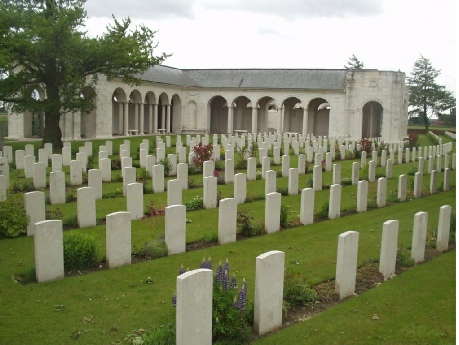
Friends
Of
Hastings
Cemetery
Le Touret Memorial (Pas de Calais) “Almost all of the men commemorated on this memorial .served with regular or territorial regiments from across the United Kingdom and were killed in actions that took place along a section of the front line that stretched from Estaires in the north to Grenay in the south. This part of the Western Front was the scene of some of the heaviest fighting of the first year of the war, including the battles of La Bassée (10 October – 2 November 1914), Neuve Chapelle (10 – 12 March 1915), Aubers Ridge (9 – 10 May 1915), and Festubert (15 – 25 May 1915). Following the British
Thiepval Memorial -
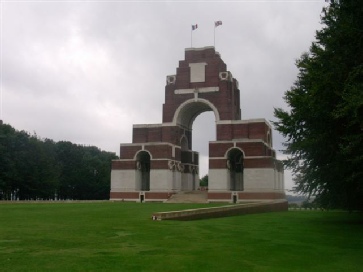
St. Pierre Cemetery is situated on the north-
During part of August 1914, Amiens was the British Advanced Base. It was captured by the Germans on 31 August, and retaken by the French on the following 13 September. The German offensive which began in March 1918 had Amiens for at least one of its objectives but the Battle of Amiens (8 -
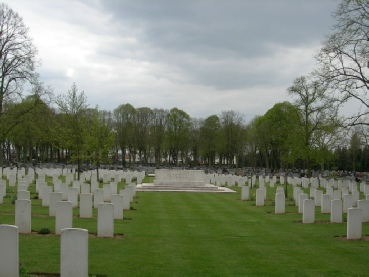
west of Jerusalem, but the city was deliberately spared bombardment and direct attack. On the 9 December, the Mayor came to the Allied lines with the Turkish Governor's letter of surrender. Jerusalem was occupied that day and on 11 December, General Allenby formally entered the city, followed by representatives of France and Italy.
Meanwhile, the 60th Division pushed across the road to Nablus, and the 53rd across the eastern road. From 26 to 30 December, severe fighting took place to the north and east of the city but it remained in Allied hands.
JERUSALEM WAR CEMETERY was begun after the occupation of the city, with 270 burials. It was later enlarged to take graves from the battlefields and smaller cemeteries in the neighbourhood.
There are now 2,514 Commonwealth burials of the First World War in the cemetery, 100 of them unidentified.
Within the cemetery stands the JERUSALEM MEMORIAL, commemorating 3,300 Commonwealth servicemen who died during the First World War in operations in Egypt or Palestine and who have no known grave.
The memorial was designed by Sir John Burnet, with sculpture by Gilbert Bayes
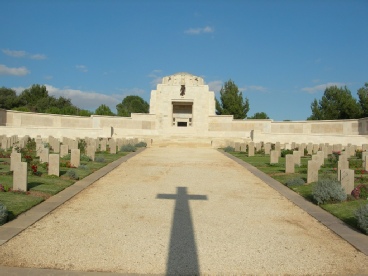
offensives, such as those which took place around Ypres to the north,or Loos to the south. Most were killed in the course of the day-
The cemetery contains 83 Commonwealth burials of the First World War and four German war graves
The cemetery, cemetery extension and memorial were designed by Harold Chalton Bradshaw, with sculpture by Gilbert Ledward

PERONNE ROAD CEMETERY, MARICOURT was, at the beginning of the Battles of the Somme 1916, the point of junction of the British and French forces, and within a very short distance of the front line; it was lost in the German advance of March 1918, and recaptured at the end of the following August.
The Cemetery, originally known as Maricourt Military Cemetery No.3, was begun by fighting units and Field Ambulances in the Battles of the Somme 1916, and used until August 1917; a few graves were added later in the War, and at the Armistice it consisted of 175 graves which now form almost the
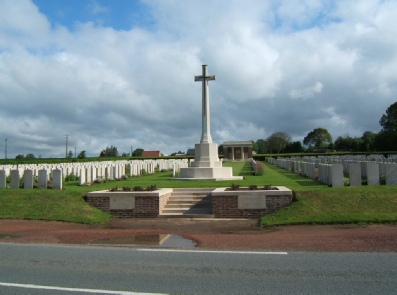
ABEELE AERODROME MILITARY CEMETERY
The cemetery, which took its name from an aerodrome that was opposite the site, was begun by French troops in April 1918 (Plot I) and extended by Commonwealth forces in the following July and August (Plot II). After the Armistice, the French graves were removed to other burial grounds and the resulting space was re-
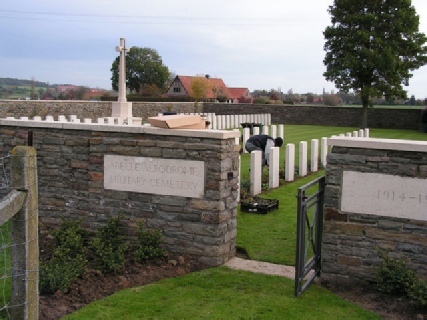
capture of the village of Neuve Chapelle in March 1915, the Germans greatly strengthened their defences along the ridge, reinforcing their positions with thick barbed wire entanglements, concrete blockhouses and machine gun emplacements. These extra defences frustrated British attempts to break through enemy lines and led to very heavy casualties at the battles of Aubers Ridge and Festubert in May 1915.”
a major battle for every village, copse and farmhouse gained. At the end of September, Thiepval was finally captured. The village had been an original objective of 1 July. Attacks north and east continued throughout October and into November in increasingly difficult weather conditions. The Battle of the Somme finally ended on 18 November with the onset of winter.
In the spring of 1917, the German forces fell back to their newly prepared defences, the Hindenburg Line, and there were no further significant engagements in the Somme sector until the Germans mounted their major offensive in March 1918.
The Thiepval Memorial, the Memorial to the Missing of the Somme, bears the names of more than 72,000 officers and men of the United Kingdom and South African forces who died in the Somme sector before 20 March 1918 and have no known grave. Over 90% of those commemorated died between July and November 1916. The memorial also serves as an Anglo-
The memorial, designed by Sir Edwin Lutyens, was built between 1928 and 1932 and unveiled by the Prince of Wales, in the presence of the President of France, on 1 August 1932 (originally scheduled for 16 May but due to the death of French President Doumer the ceremony was postponed until August).
The 7th General Hospital was at Amiens in August 1914; the 56th (South Midland) Casualty Clearing Station from April to July 1916; the New Zealand Stationary Hospital from July 1916 to May 1917; the 42nd Stationary Hospital from October 1917 to March 1919; and the 41st Stationary Hospital in March 1918, and again in December 1918 and January 1919.
The Commonwealth plot in St. Pierre Cemetery was first used in September 1915 and closed in October 1919, but shortly afterwards 33 graves of 1918 were brought in from positions in or near the city.
St. Pierre Cemetery contains 676 Commonwealth burials of the First World War.
The Commonwealth plot was designed by Sir Edwin Lutyens
The Jerusalem Memorial stands in Jerusalem War Cemetery, 4.5 kilometres north of the walled city and is situated on the neck of land at the north end of the Mount of Olives, to the west of Mount Scopus. At the outbreak of the First World War, Palestine (now Israel) was part of the Turkish Empire and it was not entered by Allied forces until December 1916. The advance to Jerusalem took a further year, but from 1914 to December 1917, about 250 Commonwealth prisoners of war were buried in the German and Anglo-
By 21 November 1917, the Egyptian Expeditionary Force had gained a line about five kilometres
Ploegsteert Memorial in Belgium. It commemorates more than 11,000 servicemen of the United Kingdom and South African forces who died in this sector during the First World War and have no known grave.
The memorial serves the area from the line Caestre-
Most of those commemorated by the memorial did not die in major
whole of Plot I. It was completed after the Armistice by the concentration of graves from the battlefields in the immediate neighbourhood and from certain smaller burial grounds.
There are now 1348, 1914-
There are now 104 Commonwealth burials of the First World War in this cemetery.
The cemetery was designed by G.H. Goldsmith.
VLAMERTINGHE NEW MILITARY CEMETERY
For much of the First World War, Vlamertinghe (now Vlamertinge) was just outside the normal range of German shell fire and the village was used both by artillery units and field ambulances. Burials were made in the original Military Cemetery until June 1917, when the New Military Cemetery was begun in anticipation of the Allied offensive launched on this part of the front in July. Although the cemetery continued in use until October 1918, most of the burials are from July to December 1917.
The cemetery now contains 1,813 Commonwealth burials of the First World War.
The cemetery was designed by Sir Reginald Blomfield.
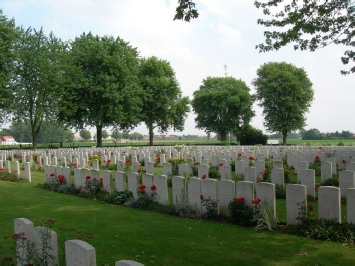
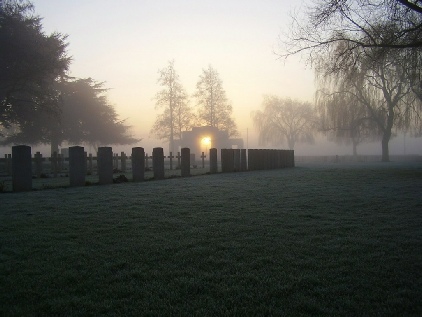
LIJSSENTHOEK MILITARY CEMETERY
During the First World War, the village of Lijssenthoek was situated on the main communication line between the Allied military bases in the rear and the Ypres battlefields.
Close to the Front, but out of the extreme range of most German field artillery, it became a natural place to establish casualty clearing stations. The cemetery was first used by the French 15th Hopital D'Evacuation and in June 1915, it began to be used by casualty clearing stations of the Commonwealth forces.
The cemetery contains 9,901
Commonwealth burials of the First World War, 24 being unidentified. There are 883 war graves of other nationalities, mostly French and German, 11 of these are unidentified. There is 1 Non World War burial here.
Eight of the headstones are Special Memorials to men known to be buried in this cemetery, these are located together alongside Plot 32 near the Stone of Remembrance.
The cemetery, designed by Sir Reginald Blomfield, is the second largest Commonwealth cemetery in Belgium.
The information on this page is mostly taken, with thanks, from the Commonwealth War Graves Commission.
Each record is linked back to the CWG page.
Individuals are linked from their page to the relevant cemetery.
- St Sever Cemetery Extension, Rouen
- Sarigol Military Cemetery, Kriston, Greece
- Sebourg British Cemetery
- Suez War Memorial Cemetery
- Thiepval Memorial
- Le Touret Memorial
- Tournai Communal Cemetery Allied Extension
- Tyne Cot Memorial
- Vimy Memorial
- Vis-
en- Artois - Vlamertinghe New Military Cemetery
- Wimereux Communal Cemetery
- Ypres (Menin Gate) Memorial
- Adanac Military Cemetery
- Abeele Aerodrome Military Memetery
- Arras Memorial
- Birr Cross Roads Cemetery, Belgium
- Cambrai Memorial, Louverval
- Canadian Cemetery no.2, Neuville-
St. Vaas t - Cement House, Cemetery, Belgium
- Chatham Naval Memorial
- Coxyde Military Cemetery
- Crouy British Cemetery, Crouy-
Sur- Somme - Doiran Memorial
- Ferme-
Olivier Cemetery
MOY-
Departement de l'Aisne, Picardie France
Two British airmen of the 1939-
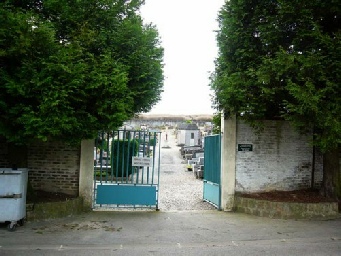

ADANAC MILITARY CEMETERY (the name was formed by reversing the name "Canada") was made after the Armistice when graves were brought in from the Canadian battlefields around Courcelette and small cemeteries surrounding Miraumont.
There are now 3,186 Commonwealth burials and commemorations of the First World War in this cemetery. 1,708 of the burials are unidentified but special memorials commemorate 13 casualties known or believed to be buried among them.
The cemetery was designed by Sir Herbert Baker.
The POZIERES MEMORIAL relates to the period of crisis in March and April 1918 when the Allied Fifth Army was driven back by overwhelming numbers across the former Somme battlefields, and the months that followed before the Advance to Victory, which began on 8 August 1918.
The Memorial commemorates over 14,000 casualties of the United Kingdom and 300 of the South African Forces who have no known grave and who died on the Somme from 21 March to 7 August 1918. The Corps and Regiments most largely represented are The Rifle Brigade with over 600 names, The Durham Light Infantry with
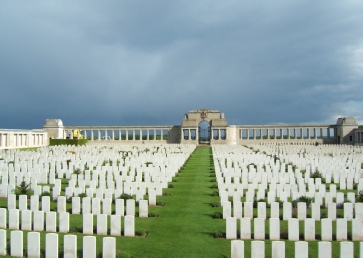
approximately 600 names, the Machine Gun Corps with over 500, The Manchester Regiment with approximately 500 and The Royal Horse and Royal Field Artillery with over 400 names.
The memorial encloses POZIERES BRITISH CEMETERY, Plot II of which contains original burials of 1916, 1917 and 1918, carried out by fighting units and field ambulances. The remaining plots were made after the Armistice when graves were brought in from the battlefields immediately surrounding the cemetery, the majority of them of soldiers who died in the Autumn of 1916 during the latter stages of the Battle of the Somme, but a few represent the fighting in August 1918.
There are now 2,758 Commonwealth servicemen buried or commemorated in this cemetery. 1,380 of the burials are unidentified but there are special memorials to 23 casualties known or believed to be buried among them. There is also 1 German soldier buried here.
The cemetery and memorial were designed by W.H. Cowlishaw, with sculpture by Laurence A. Turner. The memorial was unveiled by Sir Horace Smith-

The LOOS MEMORIAL forms the sides and back of Dud Corner Cemetery. Dud Corner Cemetery stands almost on the site of a German strong point, the Lens Road Redoubt, captured by the 15th (Scottish) Division on the first day of the battle.
The name "Dud Corner" is believed to be due to the large number of unexploded enemy shells found in the neighbourhood after the Armistice.
The Loos Memorial commemorates over 20,000 officers and men who have no known grave, who fell in the area from the River Lys to the old southern boundary of the First Army, east and west of Grenay. On either side of the cemetery is a wall 15 feet high,
to which are fixed tablets on which are carved the names of those commemorated. At the back are four small circular courts, open to the sky, in which the lines of tablets are continued, and between these courts are three semicircular walls or apses, two of which carry tablets, while on the centre apse is erected the Cross of Sacrifice.
The memorial was designed by Sir Herbert Baker with sculpture by Charles Wheeler. It was unveiled by Sir Nevil Macready on 4 August 1930.
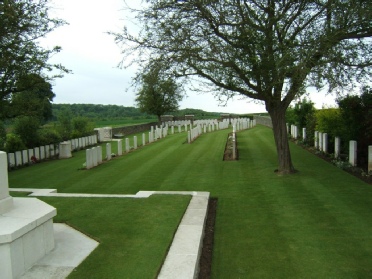
Combles village was entered in the early morning of the 26th September, 1916, by units of the 56th (London) Division and the French Army; and it remained in Allied occupation until the 24th March, 1918, when the place was captured after a subborn stand by the South African Brigade at Marrieres Wood. It was retaken on the 29th August, 1918, by the 18th Division.
The village was later "adopted", with Flers, by the County Borough of Portsmouth.
Guards' Cemetery was begun by the Guards
Division in September, 1916, and carried on by other units until March, 1917, and to a small extent in March, August and September, 1918. It contained at the Armistice 100 graves, of which 19 were those of officers and men of the Foot Guards; and it was then increased by the concentration into Plot II of graves from Priez Farm Cemetery. Six German graves of 1918 have been removed to another burial ground.
There are now nearly 200, 1914-
The cemetery covers an area of 989 square metres and is enclosed by a rubble wall.
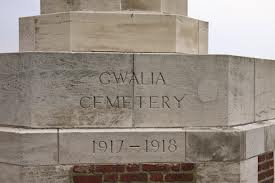
The cemetery was opened at the beginning of July 1917, in the period between the Battle of Messines and the Third Battle of Ypres. It lay among the camps in flat, wet country and was used by infantry units, artillery and field ambulances until September, 1918.
In Plot I, Row H, are buried 14 men of the 9th Lancashire Fusiliers who were killed in the early morning of 4 September 1917, in a German air raid over "Dirty Bucket Camp." The cemetery contains 467 Commonwealth burials of the First World War.
The cemetery was designed by Sir Reginald Blomfield.
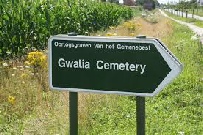
- Guards' Cemetery, Combles
- Gwalia Cemetery
- Jerusalem Memorial
- La Ferté-
sous- Jouarre Memorial to the Missing - Lijssenthoek Military CemeteryLapugnoy Military Cemetery
- Loos
- Moy-
de- Peronne Road Cemetery, Maricourtl'aisne Communal Cemetery - Philosophe British Cemetery, Mazingarbe
- Ploegsteert Memorial
- Portsmouth Naval Memoprial
- Pozieres Memorial
- St. Pierre Cemetery

After the First World War, an appropriate way had to be found of commemorating those members of the Royal Navy who had no known grave, the majority of deaths having occurred at sea where no permanent memorial could be provided.
An Admiralty committee recommended that the three manning ports in Great Britain -
In addition to commemorating seamen of the Royal Navy who sailed from Plymouth, the First World War panels also bears the names of sailors from Australia and South Africa. The governments of the other Commonwealth nations chose to commemorate their dead elsewhere, for the most part on memorials in their home ports.
Plymouth Naval Memorial commemorates 7,251 sailors of the First World War and 15,933 of the Second World War.
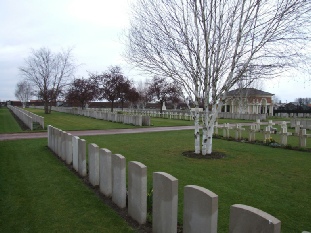
Bethune Town Cemetery contains 3,004 Commonwealth burials of the First World War,11 being unidentified.
This includes 26 men of the 1/8th Manchester Regiment who were killed by a bomb on 22 December 1917 while marching to rest billets. There are also 122 French and 87 German war graves, 38 of the German burials are unidentified.
The Commonwealth section of the cemetery was designed by Sir Edwin Lutyens.
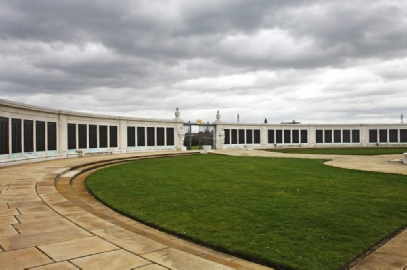
After the First World War, a way had to be found of commemorating those members of the Royal Navy who had no known grave, the majority of deaths having occurred at sea.
It was decided that the three manning ports of Chatham, Plymouth and Portsmouth should naval form, an obelisk, which would serve as a leading mark for shipping. The memorials were designed by Sir Robert Lorimer, with sculpture by Henry Poole. The Chatham Naval Memorial was unveiled by
the Prince of Wales (the future King Edward VIII) on 26 April 1924. Chatham Naval Memorial commemorates 8,517 sailors of the First World War.
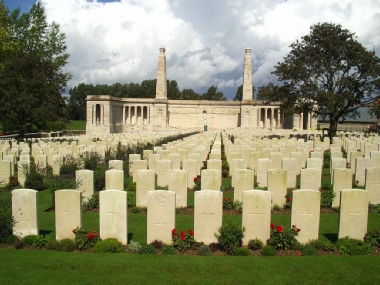
This Memorial bears the names of over 9,000 men who fell in the period from 8 August 1918 to the date of the Armistice in the Advance to Victory in Picardy and Artois, between the Somme and Loos, and who have no known grave. They belonged to the forces of Great Britain and Ireland and South Africa; the Canadian, Australian and New Zealand forces being commemorated on other memorials to the missing.
In the middle of the screen, is a group in relief representing St George and the Dragon.
The memorial was designed by J.R. Truelove, with sculpture by Ernest Gillick.
The TYNE COT MEMORIAL now bears the names of almost 35,000 officers and men whose graves are not known. The memorial, designed by Sir Herbert Baker with sculpture by Joseph Armitage and F.V. Blundstone, was unveiled by Sir Gilbert Dyett on 20 June 1927.
The memorial forms the north-
The cemetery was designed by Sir Herbert Baker.
After the First World War, an appropriate way had to be found of commemorating those members of the Royal Navy who had no known grave, the majority of deaths having occurred at sea where no permanent memorial could be provided.
An Admiralty committee recommended that the three manning ports in Great Britain -
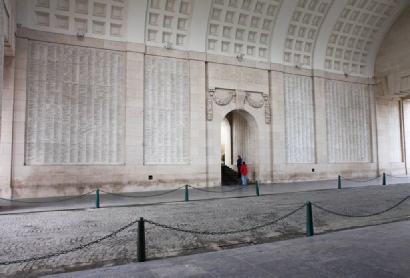
The site of the Menin Gate was chosen because of the hundreds of thousands of men who passed through it on their way to the battlefields. In the case of United Kingdom casualties, only those prior 16 August 1917 (with some exceptions).
It now bears the names of more than 54,000 officers and men whose graves are not known. The memorial, designed by Sir Reginald Blomfield with sculpture by Sir William Reid-
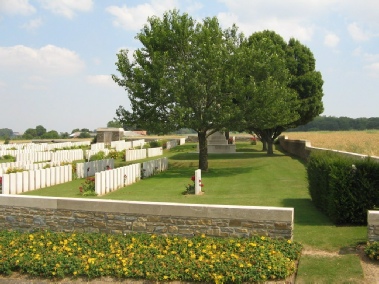
Crouy British Cemetery, Crouy-
The cemetery was used between April and August 1918 for burials from the 5th and 47th Casualty Clearing Stations, which had come to the village because of the German advance.
In October 1919, 42 graves were brought to Crouy from the small military cemetery at Riviere. These burials had been made from the 12th, 53rd and 55th Casualty Clearing Stations at Longpre-
The cemetery now contains 739 Commonwealth burials of the First World War, and a number of French and German war graves. The cemetery was designed by Sir Reginald Blomfield.
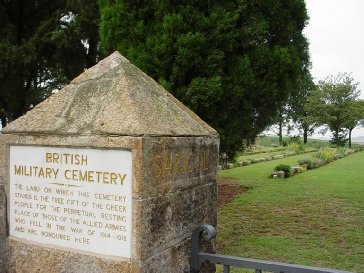
From April to June 1917, the 35th Casualty Clearing Station was at Sarigol. It was replaced by the 21st Stationary Hospital, which remained until December 1918. From these two hospitals, 150 burials were made in the cemetery, many of them men who had been wounded in the Allied attack on the Grand-
In February 1921, 560 graves were brought into Sarigol from Janes Military Cemetery, a few miles to the north, and serving the same front. With a few exceptions, the burials were made from 31st Casualty Clearing Station between August 1916 and October 1918. Sarigol Military Cemetery now contains 682 Commonwealth burials of the First World War and 29 war graves of other nationalities.
Canada Farm Cemetery, Belgium, took its name from a farmhouse used as a dressing station during the 1917 Allied offensive on this front.
Most of the burials are of men who died at the dressing station between June and October 1917.
There are now 907 First World War burials in the cemetery.
The cemetery was designed by Sir Reginald Blomfield.
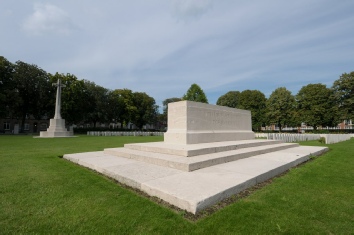
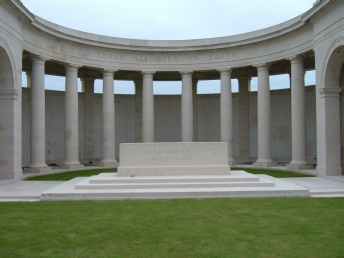
Commemorates more than 7,000 servicemen of the United Kingdom and South Africa who died in the Battle of Cambrai in November and December 1917 and whose graves are not known.
The Cambrai Memorial was designed by Harold Chalton Bradshaw with sculpture by Charles S. Jagger. It was unveiled by Lieut-
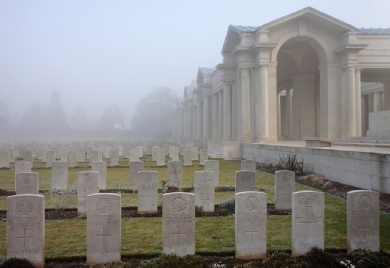
The ARRAS MEMORIAL commemorates almost 35,000 servicemen from the United Kingdom, South Africa and New Zealand who died in the Arras sector between the spring of 1916 and 7 August 1918, the eve of the Advance to Victory, and have no known grave.
Both cemetery and memorial were designed by Sir Edwin Lutyens, with sculpture by Sir William Reid Dick. The memorial was unveiled by Lord Trenchard, Marshal of the Royal Air Force on the 31 July 1932.
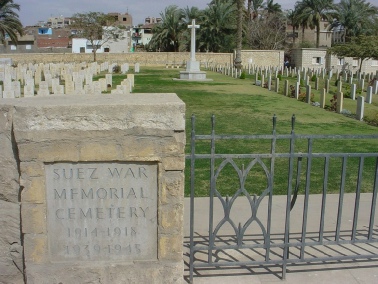
Initially, burials took place in a special plot in the Protestant cemetery but the War Memorial Cemetery was established nearby in 1918 and these graves were transferred there, together with some from other burial grounds. Later, the adjoining Arbain Indian Cemetery was also absorbed into it.
There are now 513 Commonwealth casualties of the First World War

Philosophe British Cemetery, Mazingarbe
Succeeding divisions used the cemetery until October 1918, and men of the same Division, and often the same battalion, were buried side by side.
The bodies of 41 men of the 9th Black Watch were brought from positions a little West of Loos, and those of 340 officers and men of other Regiments from different points in the surrounding communes.
There are now 1,996 Commonwealth burials of the First World War in the cemetery, 277 of them unidentified.
The cemetery was designed by Sir Herbert Baker.
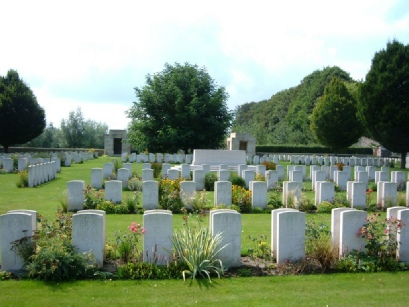
Tournai Communal Cemetery Allied Extension
The (Southern) Communal Cemetery, in the Faubourg-
The Allied extension now contains 689 Commonwealth burials of the First World War, 34 of them unidentified. There are also 117 Russian burials, all of men who died as prisoners of war, and two Belgian war graves.
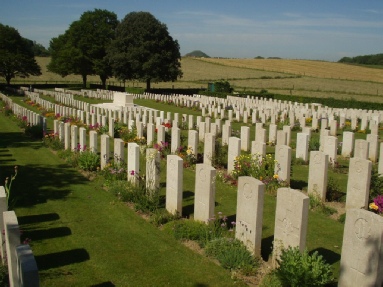
The first burials were made in Plot I of the cemetery in September 1915, but it was most heavily used during the Battle of Arras, which began in April 1917. The dead were brought to the cemetery from casualty clearing stations, chiefly the 18th and the 23rd at Lapugnoy and Lozinghem, but between May and August 1918 the cemetery was used by fighting units.
Lapugnoy Military Cemetery contains 1,324 Commonwealth burials of the First World War, 3 being unidentified, and 11 from the Second World War, all dating from May 1940.
The cemetery was designed by Sir Edwin Lutyens.
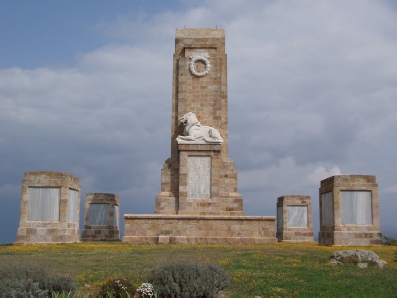
The Doiran Memorial
It marks the scene of the fierce fighting of 1917-
The memorial serves the dual purpose of Battle Memorial of the British Salonika Force (for which a large sum of money was subscribed by the officers and men of that force), and place of commemoration for more than 2,000 Commonwealth servicemen who died in Macedonia and whose graves are not known.
The memorial was designed by Sir Robert Lorimer with sculpture by Walter Gilbert.
“Cement House" was the military name given to a fortified farm building on the Langemark-
The original Cement House Cemetery (now Plot I, an irregular group of 231 graves) was begun here at the end of August 1917 and used by the 4th and 17th Division burial officers, by field ambulances and by units in the line until April 1918.
Following the Armistice, Commonwealth graves were brought in from the battlefields and small burial grounds around, mostly dating from the Autumn of 1917.
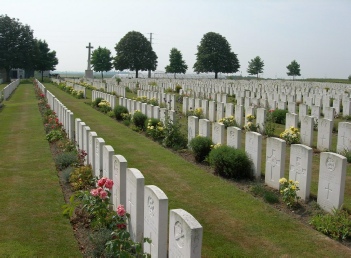
There are now 3,592 Commonwealth servicemen of the First World War buried or commemorated in the cemetery, 2,425 of the burials are unidentified.
The cemetery was designed by Sir Reginald Blomfield.
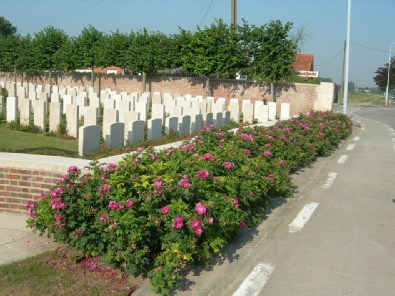
Birr Cross Roads Cemetery, Belgium
The cemetery was begun in August 1917 and used as a Dressing Station cemetery until, and after, the German advance in 1918. At the Armistice, it contained nine irregular rows of graves, now part of Plot I, but was greatly enlarged when graves were brought in from the surrounding battlefields and from certain smaller cemeteries.
There are now 833 Commonwealth servicemen of the First World War buried or commemorated in this cemetery.
The cemetery was designed by Sir Edwin Lutyens.
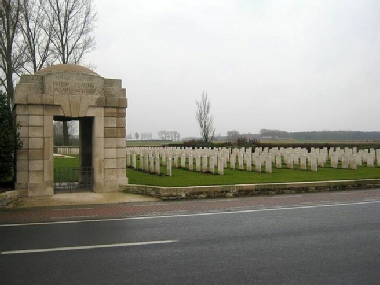
The cemetery was used continuously between 9 June 1915 and 5 August 1917, with 6 Field Ambulances successively having dressing stations close by.
The cemetery contains 408 Commonwealth burials of the First World War, 6 of which are unidentified, and three German war graves.
The cemetery was designed by Sir Reginald Blomfield.
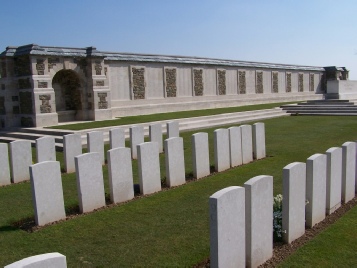
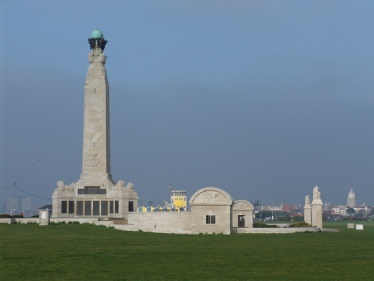
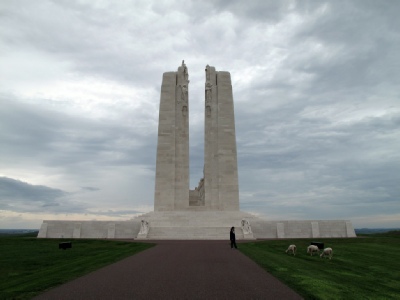
On the opening day of the Battle of Arras,the four divisions of the Canadian Corps, fighting side by side for the first time, scored a huge tactical victory in the capture of the 60 metre high Vimy Ridge.
After the war, the highest point of the ridge was chosen as the site of the great memorial to all Canadians who served their country in battle during the First World War, and particularly to the 60,000 who gave their lives in France. It also bears the names of 11,000 Canadian servicemen who died in France -
The memorial was designed by W.S. Allward. It was unveiled by King Edward VIII on 26 July 1936.
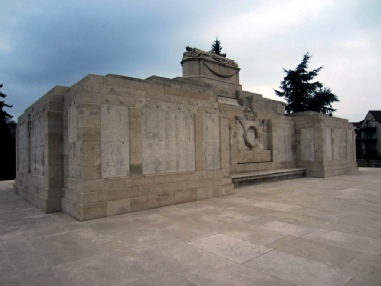
La Ferté-
The La Ferté-
The memorial was designed by George H. Goldsmith, a decorated veteran of the Western Front, and unveiled by Sir William Pulteney, who had commanded the III Corps of the BEF in 1914, on 4 November 1928.
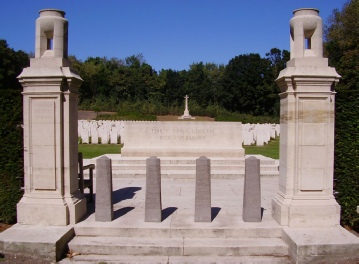
Coxyde (now Koksijde) The cemetery, which had been started by French troops, was found to be reasonably safe. It became the most important of the Commonwealth cemeteries on the Belgian coast and was used at night for the burial of the dead brought back from the front line.
The cemetery contains 1,507 Commonwealth burials of the First World War, the French graves from this period having since been removed.
The cemetery was designed by Sir Edwin Lutyens.
Canadian Cemetery no.2, Neuville-
The cemetery was established by the Canadian Corps after the successful storming of Vimy Ridge on 9th April, 1917 and some of those buried in the cemetery fell in that battle or died of wounds received there, though the majority of the graves were made later for the burial of the dead recovered from surrounding battlefields and from isolated graves which were transferred into the cemetery over a period of years after the Armistice.
There are nearly 3,000, 1914-
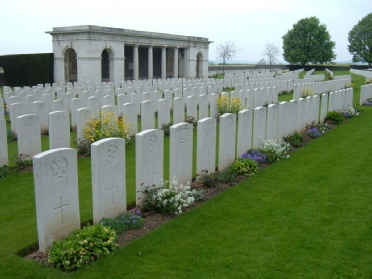
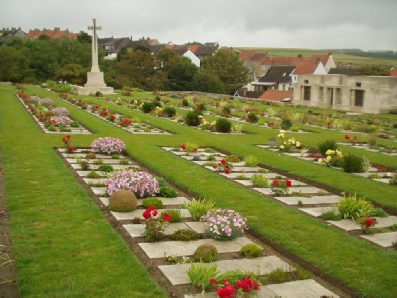
Wimereux was the headquarters of the Queen Mary's Army Auxilliary Corps during the First World War and in 1919 it became the General Headquarters of the British Army.
From October 1914 onwards, Boulogne and Wimereux formed an important hospital centre and until June 1918, the medical units at Wimereux used the communal cemetery for burials, the south-
Wimereux Communal Cemetery contains 2,847, Commonwealth burials of the First World War, two of them unidentified.
The Commonwealth section was designed by Charles Holden.
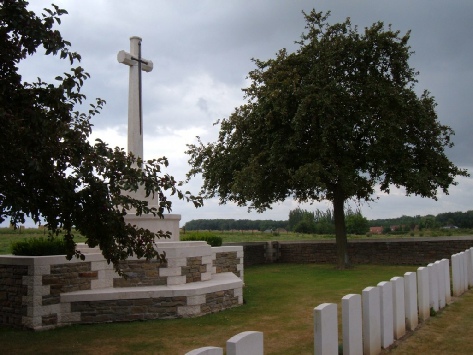
The neighbourhood of Sebourg was the scene of fighting in November 1918 during the crossing of the river Aunelle.
Sebourg British Cemetery contains 61 Commonwealth burials of the First World War, five of which are unidentified.
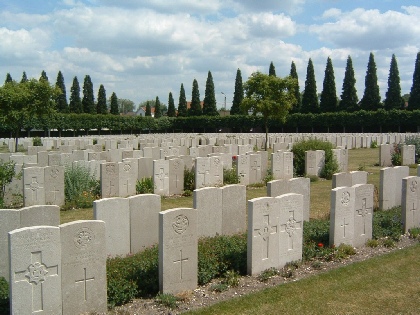
St Sever Cemetery Extension, Rouen
The great majority of the war dead were taken to the city cemetery of St. Sever. In September 1916, it was found necessary to begin an extension where the last burial took place in April 1920.
The cemetery extension contains 8,348 Commonwealth burials of the First World War (ten of them unidentified).
The Commonwealth plots were designed by Sir Reginald Blomfield.
